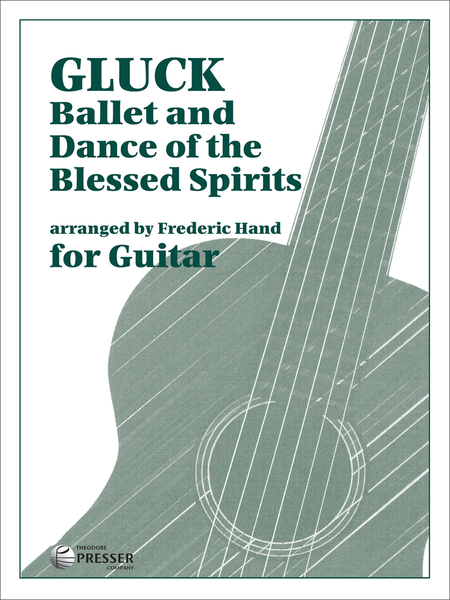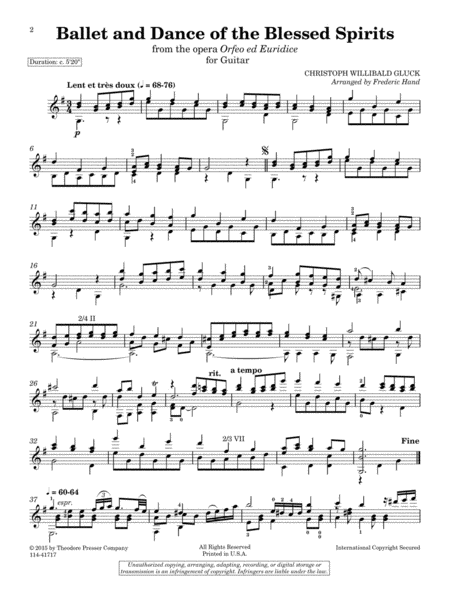Ballet and Dance of the Blessed Spirits
from the opera "Orfeo ed Euridice"
-
Ships in 1 to 2 weeks
Details
Description
SKU: PR.114417170
From the opera "Orfeo ed Euridice". Composed by Christoph Gluck. Arranged by Frederic Hand. -. Classical. Performance Score. With Standard notation. Composed 2014. 4 pages. Duration 4:30. Theodore Presser Company #114-41717. Published by Theodore Presser Company (PR.114417170).ISBN 9781491100554. UPC: 680160626946. 9x12 inches. Key: G major.
An early favorite of Hand's was Segovia's transcription of the outer section of the Gluck classic. He now completes the Ballet and Dance for solo guitar, using key and rhythm changes to lie better upon the fretboard.________________________Text from the scanned back cover:BALLET AND DANCE OF THE BLESSED SPIRITSfrom the opera “Orfeo ed Euridice”Gluck’s Dance of the Blessed Spirits has been long belovedamong guitarists through Segovia’s edition of its outersection. In this new transcription, Frederic Hand providesa solo guitar version of the complete dance movement. ARRANGER'S NOTE BY FREDERIC HANDWhen I was 6 years old, a favorite piece on my first Andres Segovia LP was his arrangement of the outer section of Gluck’s Dance of the Blessed Spirits from the opera “Orfeo ed Euridice.” Decades later I discovered that there was a second part that Segovia didn’t transcribe. Its haunting beauty compelled me to make an arrangement. The original key of F major is not suitable for the guitar due to the lack of needed open bass strings for the primary harmonies. For that reason, Segovia made his arrangementin A major. In combining both movements, I chose G major for the opening section so the relative minor section would fall in the key of E minor. In the second part, the original string accompanimentbeneath the flute melody is a constant stream of 16th notes in thirds. It is not possible to play the melody, authentic accompaniment, and bass parts on a single guitar. To capture the essential quality of the accompaniment, I’ve maintained the same intervalic relationships within the two violin figures, butchanged the underlying pulse from 16th notes to 8ths. For that reason (and also the guitar’s relative lack of sostenuto compared with the flute) it is helpful to play the Dance at a brighter tempo than is traditionally performed with flute and strings. FREDERIC HAND is graduate of The Mannes College of Music. He was a Fulbright Scholar to England and a student of Julian Bream. His solo performances, both in North and South America,and in Europe, have received the highest critical acclaim. The New York Times has written, “He played unerringly, with all the verve and spirit that one could ask.” Appointed the Metropolitan Opera’sguitarist and lutenist in 1984, he has accompanied Placido Domingo, Luciano Pavarotti, Renee Fleming, and many other renowned singers.His scores for television earned him an Emmy Award, and his arrangement and performance of the theme for the film “Kramer vs. Kramer” led to his own best-selling recording for Sony, “Baroque and On the Street.” He has also recorded for BMG and the Musical Heritage Society.He has been an Affiliate Artist with the State Arts Councils of New York, California, Colorado, Arizona and Washington, and has given master classes at Yale, Dartmouth, New England Conservatory, andthe Cleveland Institute of Music. Guest appearances include the New York Philharmonic, Vienna Philharmonic, Mostly Mozart Festival, Marlboro Music Festival, and the Caramoor Festival with the Orchestra of St. Lukes. For his recording and performances with flutist Paula Robison, he won the Classical Recording Foundation’s “Samuel Sanders Award.” .
Text from the scanned back cover:Arranger’s Note by Frederic HandWhen I was 6 years old, a favorite piece on my first Andres Segovia LP was his arrangement of theouter section of Gluck’s Dance of the Blessed Spirits from the opera “Orfeo ed Euridice.” Decades laterI discovered that there was a second part that Segovia didn’t transcribe. Its haunting beauty compelledme to make an arrangement. The original key of F major is not suitable for the guitar due to the lack ofneeded open bass strings for the primary harmonies. For that reason, Segovia made his arrangementin A major. In combining both movements, I chose G major for the opening section so the relativeminor section would fall in the key of E minor. In the second part, the original string accompanimentbeneath the flute melody is a constant stream of 16th notes in thirds. It is not possible to play themelody, authentic accompaniment, and bass parts on a single guitar. To capture the essential quality ofthe accompaniment, I’ve maintained the same intervalic relationships within the two violin figures, butchanged the underlying pulse from 16th notes to 8ths. For that reason (and also the guitar’s relativelack of sostenuto compared with the flute) it is helpful to play the Dance at a brighter tempo than istraditionally performed with flute and strings.


 Share
Share